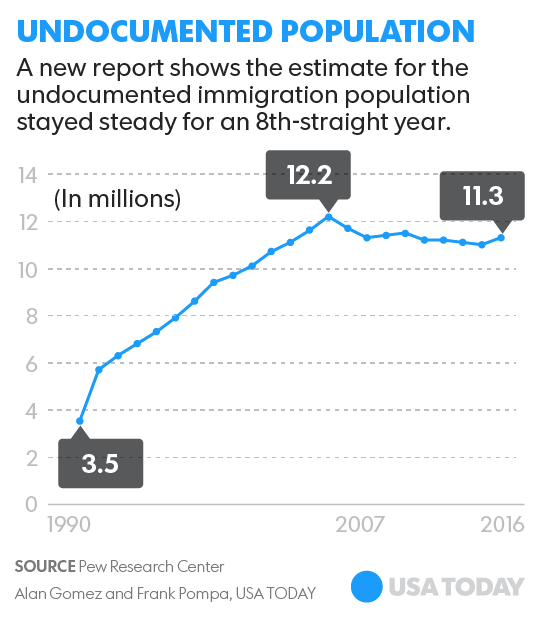Undocumented immigrant population in U.S. stays flat for eighth straight year
The number of undocumented immigrants living in the United States stayed steady for an eighth straight year in 2016 with 11.3 million people, according to a report published Tuesday.

The gradual improvement of the Mexican economy, the federal government's additions to border security and a shift in the demographics of Latin America all contributed to the nearly decade-long freeze in illegal immigration, according to the report by Pew Research Center. There was nearly two decades of growth in immigration throughout the 1990s and 2000s.
Still, President Trump is cracking down on illegal immigration and increasing deportations. White House counselor Kellyanne Conway said on Fox News that the proposed border wall with Mexico remains a priority for Trump but does not have to be funded in this week's spending bill, making it easier for Congress to avert a government shutdown.
Critics say the numbers in the Pew report show how misguided those efforts are.

"It feels like it's out of step with what the U.S. really needs right now," said Angela Kelley, senior strategic adviser for immigration at the Open Society Policy Center. "Of course we need to enforce our border, and we do that rigorously. But rather than the bluster of the border wall, it would show real leadership if this administration could deal sensibly with the 11 million people living here."
The White House says it's simply responding to the will of the voters by making illegal immigration a central focus. On Monday, White House press secretary Sean Spicer was asked why the president insists on more funding for border security when the number of people caught crossing the southwest border with Mexico has plummeted in the first months of his term.
"Just because you have a couple good months in a year, I think you want to make sure that you take prudent long-term steps," Spicer said. "(The wall) is a permanent step that will extend beyond his presidency. Eight years from now, the new president will have that wall in place to make sure that it doesn't continue."
Read more:
Government shutdown less likely now that Trump has relented on border wall
White House may be relenting on demand for immediate border wall funding
'Physically imposing': Here are the design specs for Trump's border wall
More Mexicans leave than enter USA in historic shift
The report also shows how quickly the nature of illegal immigration has changed in recent years.
Mexicans have made up a majority of the undocumented immigrant population for decades, but that was no longer the case in 2016. For the first time, Mexicans made up only 50% of the population, showing how much illegal immigration from America's southern neighbor has slowed.
In fact, the number of undocumented immigrants from Mexico dropped from 6.4 million in 2009 to 5.6 million in 2015, according to Pew.
Jeffrey Passel, senior demographer at Pew and co-author of the report, said several factors have contributed to the decline. The Mexican economy has improved in recent years, meaning Mexicans have more economic opportunities there. He said the U.S. Border Patrol has increased over several past presidential administrations, making crossing much harder and more expensive. And he said the demographics have changed considerably, with Mexican women giving birth to fewer children, leaving fewer potential immigrants and smaller networks for them living in the U.S.
"It used to be that every kid in rural Mexico had an uncle in the United States," Passel said. "Now there's not as many."
As illegal immigration from Mexico has slowed, people from other countries have stepped in.
The number of Central Americans has increased from 1.6 million in 2009 to 1.8 million in 2015, as people from El Salvador, Guatemala and Honduras flee violence in their countries. The U.S. has also seen an increase in the number of undocumented immigrants from Asia, Africa and the Middle East.
Passel said that shows the influence of visa overstays — people who legally enter the country on a valid visa but stay after it expires. And while that trend has been developing over the years, "It has been a fairly rapid change."
